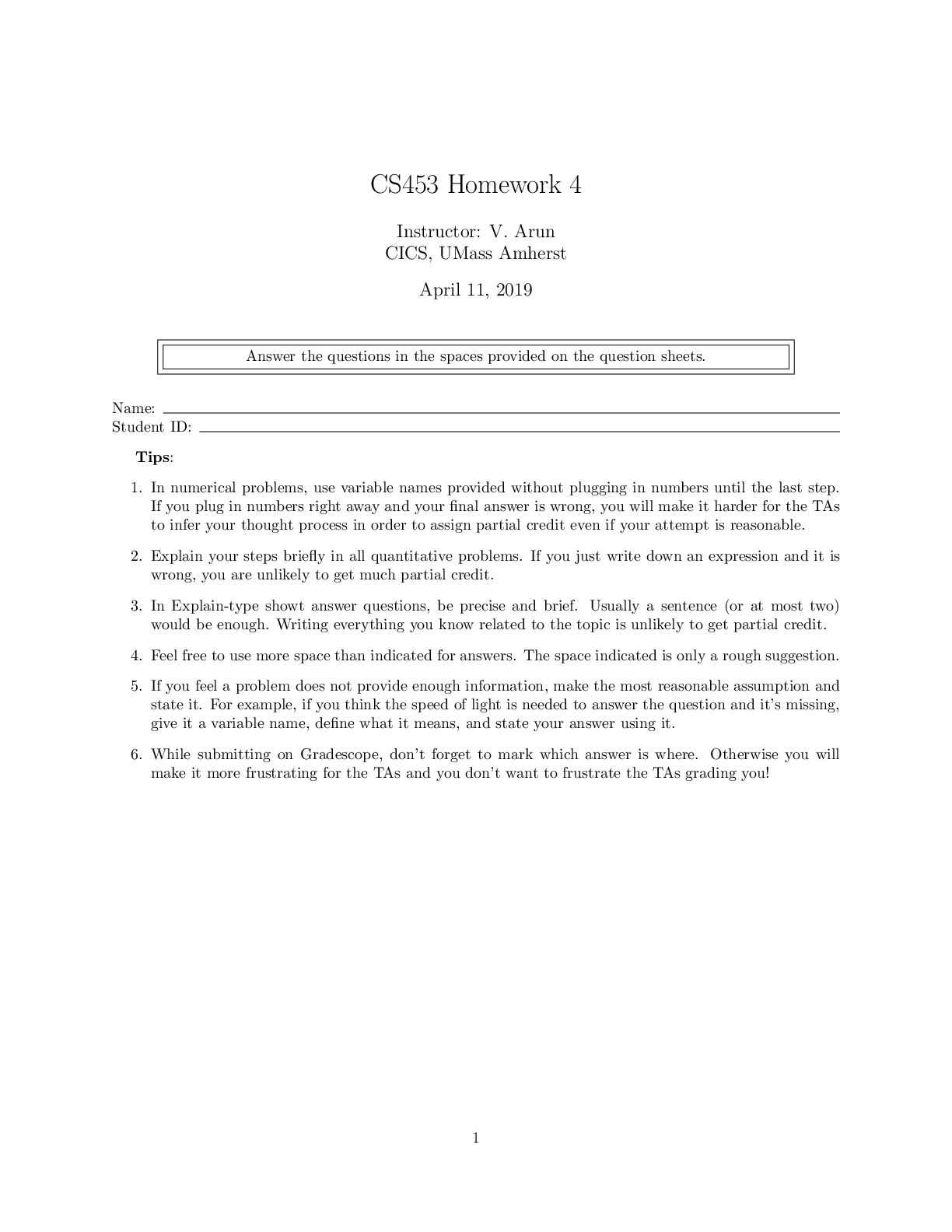Computer Science > QUESTION PAPER (QP) > University of Massachusetts, Amherst - CS 453CS453_HW4_S19 (All)
University of Massachusetts, Amherst - CS 453CS453_HW4_S19
Document Content and Description Below
CS453 Homework 4 Instructor: V. Arun CICS, UMass Amherst April 11, 2019 Answer the questions in the spaces provided on the question sheets. Name: Student ID: Tips: 1. In numerical problems, us... e variable names provided without plugging in numbers until the last step. If you plug in numbers right away and your final answer is wrong, you will make it harder for the TAs to infer your thought process in order to assign partial credit even if your attempt is reasonable. 2. Explain your steps briefly in all quantitative problems. If you just write down an expression and it is wrong, you are unlikely to get much partial credit. 3. In Explain-type showt answer questions, be precise and brief. Usually a sentence (or at most two) would be enough. Writing everything you know related to the topic is unlikely to get partial credit. 4. Feel free to use more space than indicated for answers. The space indicated is only a rough suggestion. 5. If you feel a problem does not provide enough information, make the most reasonable assumption and state it. For example, if you think the speed of light is needed to answer the question and it’s missing, give it a variable name, define what it means, and state your answer using it. 6. While submitting on Gradescope, don’t forget to mark which answer is where. Otherwise you will make it more frustrating for the TAs and you don’t want to frustrate the TAs grading you! 11. (30 points) (Quick questions) Read RFC 6298 (especially Section 2) carefully to answer the parts about implementing TCP retransmission timeouts. (a) Suppose a TCP endpoint received the following sample RTT values since the beginning of the connection: 80, 84, 90, 86, all in milliseconds. What are the values of the smoothed round-trip time, SRTT (also known as \estimated RTT" in the textbook), and the retransmission timeout, RTO, at the end of these four samples. Assume the clock granularity is below well below a microsecond. (b) Suppose the current value of the SRTT is 87.8 ms. Suppose the next RTT sample is 92 ms. Explain under what circumstances is it possible that the updated value of SRTT does not increase upon receiving this sample. (c) Suppose the current value of RTO is 1.2 secs and the timer expires. Does the RTO change? If yes, what is the new value? If no, explain why not. (d) TCP’s method of computing the smoothed RTT is referred to as \exponentially" weighted moving average (EWMA). Explain mathematically (i.e., using abstract math, not just English) what is \exponential" in this averaging method. Page 2(e) Explain concisely what head-of-the-line blocking means noting whether it occurs at the input port or output port at a router. (f) For a given arrival sequence of packets, a Weighted Fair Queuing (WFQ) scheduler can always implement a schedule of packet departures that matches a Round Robin (RR) scheduler but not necessarily one that matches a FIFO scheduler. Defend this statement with an explanation. Page 32. (24 points) (Reliable transport FSMs) (a) (Chapter 3, P17) Consider two network entities, A and B, which are connected by a perfect bidirectional channel (i.e., any message sent will be received correctly; the channel will not corrupt, lose, or re-order packets). A and B are to deliver data messages to each other in an alternating manner: First, A must deliver a message to B, then B must deliver a message to A, then A must deliver a message to B, and so on. If an entity is in a state where it should not attempt to deliver a message to the other side, and there is an event like rdt_send(data) call from above that attempts to pass data down for transmission to the other side, this call from above can simply be ignored with a call to rdt_unable_to_send(data), which informs the higher layer that it is currently unable to send data. [Note: This simplifying assumption is made so you don’t have to worry about buffering data.] Draw an FSM specification for this protocol (one FSM for A, and one FSM for B). Note that you do not have to worry about a reliability mechanism here; the main point of this question is to create an FSM specification that reflects the synchronized behavior of the two entities. You should use the following events and actions that have the same meaning as protocol rdt 1.0 in Figure 3.9: rdt_send(data), make_pkt(data), udt_send(packet), rdt_rcv(packet), extract(packet, data), deliver_data(data). Make sure your protocol reflects the strict alternation of sending between A and B. Also, make sure to indicate the initial states for A and B in your FSM descriptions. [Show More]
Last updated: 2 years ago
Preview 1 out of 8 pages

Buy this document to get the full access instantly
Instant Download Access after purchase
Buy NowInstant download
We Accept:

Reviews( 0 )
$3.00
Can't find what you want? Try our AI powered Search
Document information
Connected school, study & course
About the document
Uploaded On
Apr 13, 2021
Number of pages
8
Written in
Additional information
This document has been written for:
Uploaded
Apr 13, 2021
Downloads
0
Views
238










.png)


